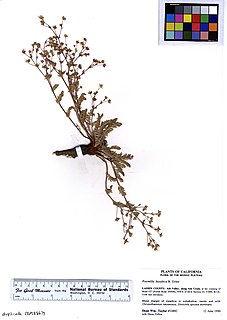
Taxodium mucronatum, commonly known as Montezuma bald cypress, Montezuma cypress, or ahuehuete, is a species of Taxodium that is primarily native to Mexico and Guatemala, with a few populations in the southwestern United States. Ahuehuete is derived from the Nahuatl name for the tree, āhuēhuētl, which means "upright drum in water" or "old man of the water."

El Árbol del Tule is a tree located in the church grounds in the town center of Santa María del Tule in the Mexican state of Oaxaca, approximately 9 km (6 mi) east of the city of Oaxaca on the road to Mitla. It is a Montezuma cypress, or ahuehuete. It has the stoutest tree trunk in the world. In 2001, it was placed on a UNESCO tentative list of World Heritage Sites, but was removed from the list in 2013.

The Government Botanical Garden is a botanical garden in Udhagamandalam, near Coimbatore (Ooty), Tamil Nadu state, India laid out in 1848. The Gardens, divided into several sections, cover an area of around 55 acres, and lie on the lower slopes of Doddabetta peak. The garden has a terraced layout. It is maintained by the Tamil Nadu Horticulture Department.

Lycianthes is a genus of plants from the nightshade family (Solanaceae), found in both the Old World and the New World, but predominantly in the latter. It contains roughly 150 species, mostly from tropical America, with 35-40 species in Asia and the Pacific.

Phragmidium rubi-idaei is a plant pathogen infecting caneberries, Rubus spp.

Pithecellobium is a genus of flowering plants in the family Fabaceae. The generic name is derived from the Greek words πίθηκος (pithêkos), meaning "ape" or "monkey," and ἐλλόβιον (ellobion), meaning "earring," which refers to the coiled shape of the fruit pods. Plants of the genus are known generally as blackbeads.
"Solanum mucronatum" is a flowering plant species in the nightshade family (Solanaceae). It probably belongs to those species formerly in Solanum but nowadays placed in Lycianthes, though its exact identity and name remain undetermined.

Azaleatin is a chemical compound. It is an O-methylated flavonol, a type of flavonoid. It was first isolated from the flowers of Rhododendron mucronatum in 1956 and has since been recorded in forty-four other Rhododendron species, in Plumbago capensis, in Ceratostigma willmottiana and in Carya pecan. It has been also been found in the leaves of Eucryphia.
Halopyrum is a genus of Asian and African plants in the grass family. The only known species is Halopyrum mucronatum, native to the Indian Subcontinent, Iran, the Arabian Peninsula, Socotra, Madagascar, and eastern + northeastern Africa.

The Phragmidiaceae are a family of rust fungi in the order Pucciniales. The family contains 14 genera and 164 species.
Distichophytum is a genus of extinct vascular plants of the Late Silurian (Ludfordian) to Early Devonian (Emsian), around 426 to 393 million years ago. The genus has a tangled taxonomic history, also being known as Bucheria and Rebuchia.

An aecium is a specialised reproductive structure found in some plant pathogenic rust fungi that produce aeciospores. Aecia may also be referred to as "cluster cups". The term aecidium is used interchangeably but is not preferred.

Phragmidium is a genus of rust fungus that typically infects plant species in the family Rosaceae. It is characterised by having stalked teliospores borne on telia each having a row of four or more cells. All species have a caeoma which is a diffuse aecidium lacking a peridium.
Coleophora majuscula is a moth of the family Coleophoridae. It is found in Azerbaijan.

Potentilla basaltica is a species of flowering plant in the rose family known by the common names Soldier Meadows cinquefoil and basalt cinquefoil. It is endemic to a small area of the Modoc Plateau and Warner Mountains in northeastern California and northwestern Nevada.

Rhododendron mucronatum is a rhododendron species native to China, where it grows at altitudes of 2,800–4,500 m (9,200–14,800 ft). This evergreen shrub grows to 1–2 m (3.3–6.6 ft) in height, with leaves that are lanceolate to ovate-lanceolate or oblong-lanceolate, 2–6 by 0.5–1.8 cm in size. The flowers are white, pink, or pale red.

Rhododendron pulchrum (锦绣杜鹃), also identified as Rhododendron × pulchrum, is a rhododendron endemic to China. It grows as a semi-evergreen shrub, 1.5–2.5 m (4.9–8.2 ft) in height, with leathery leaf blades, elliptic-oblong to elliptic-lanceolate or oblong-oblanceolate, 2–5(–7) × 1–2.5 cm in size. The flowers are rose-purple with dark red flecks. Hirsutum describes it as "a natural hybrid; seed × pollen= R. mucronatum var mucronatum × R. indicum var formosanum".

Vincent W. Cochrane was an American mycologist, whose research focused on the biochemistry and physiology of fungi. He is particularly known for his 1958 textbook, The Physiology of the Fungi.
Spyridium mucronatum is a species of flowering plant in the family Rhamnaceae and is endemic to the south of Western Australia. It is an erect or spreading shrub usually with narrowly oblong leaves, and dense clusters of up to ten densely hairy, white to yellow flowers.













